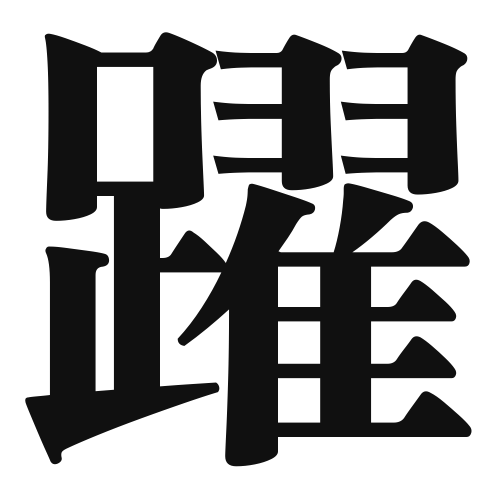1. Overview of Meaning
The kanji “躍” (yaku) means “to leap” or “to jump.” It conveys a sense of energetic movement and excitement, often associated with lively actions or events.
2. Formation and Radical
Formation of the Kanji: The kanji “躍” is a compound character (会意文字) that combines elements to convey its meaning. It consists of the radical for “foot” (足) and the character “躍” itself, which suggests movement and action.
Radical: The radical of “躍” is 足 (ashi), which means “foot.” This radical emphasizes the action of jumping or leaping.
3. Examples of Usage
Common Words and Phrases: Some frequently used words that include “躍” are:
- 躍動 (yakudō) – “activity” or “vitality”
- 躍進 (yakushin) – “advance” or “progress”
Example Sentences in Daily Conversation:
- 彼は躍動感のあるダンスを踊った。
(Kare wa yakudōkan no aru dansu o odotta.)
“He danced with a sense of vitality.” - 新しいプロジェクトが躍進することを期待しています。
(Atarashii purojekuto ga yakushin suru koto o kitai shiteimasu.)
“I hope the new project will make great progress.”
4. Synonyms and Antonyms
Similar Kanji: A similar kanji is “跳” (chō), which also means “to jump” but often implies a more playful or casual action, while “躍” suggests a more vigorous or energetic leap.
Opposite Kanji: An antonym is “静” (sei), which means “quiet” or “calm,” representing stillness as opposed to the dynamic movement implied by “躍.”
5. Cultural and Historical Background
Relation to Japanese Culture: The concept of “躍” is often associated with traditional Japanese arts, such as dance and martial arts, where movement and energy play a crucial role.
Proverbs and Idioms: One common expression is “躍如鯉” (yaku no koi), which means “to leap like a carp,” symbolizing success and vitality in one’s endeavors.
